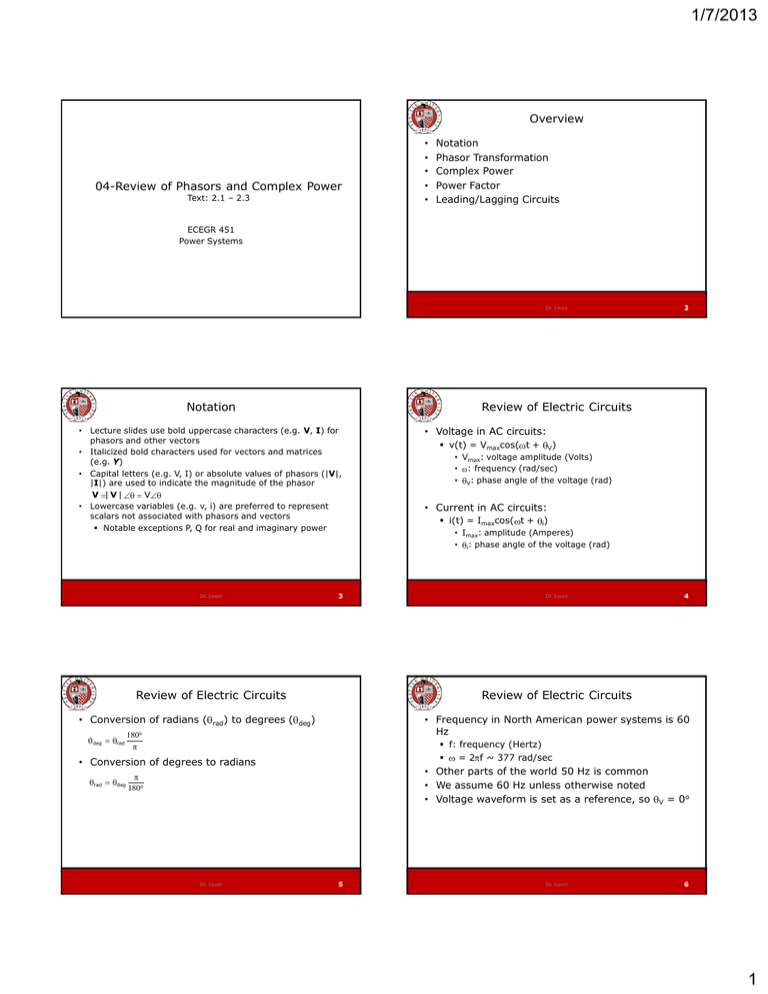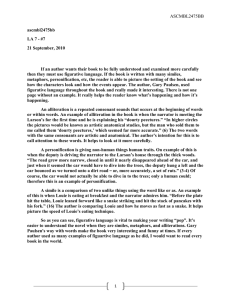04-Phasors and Power Review
advertisement

1/7/2013
Overview
04-Review of Phasors and Complex Power
Text: 2.1 – 2.3
•
•
•
•
•
Notation
Phasor Transformation
Complex Power
Power Factor
Leading/Lagging Circuits
ECEGR 451
Power Systems
2
Dr. Louie
Notation
Review of Electric Circuits
• Lecture slides use bold uppercase characters (e.g. V, I) for
phasors and other vectors
• Italicized bold characters used for vectors and matrices
(e.g. Y)
• Capital letters (e.g. V, I) or absolute values of phasors (|V|,
|I|) are used to indicate the magnitude of the phasor
V |V|
V
• Lowercase variables (e.g. v, i) are preferred to represent
scalars not associated with phasors and vectors
Notable exceptions P, Q for real and imaginary power
3
Dr. Louie
Review of Electric Circuits
• Conversion of radians (
rad)
to degrees (
deg)
i(t) = Imaxcos( t +
i)
• Imax: amplitude (Amperes)
• i: phase angle of the voltage (rad)
4
Dr. Louie
• Other parts of the world 50 Hz is common
• We assume 60 Hz unless otherwise noted
• Voltage waveform is set as a reference, so
180
Dr. Louie
• Current in AC circuits:
f: frequency (Hertz)
= 2 f ~ 377 rad/sec
rad
deg
V)
• Vmax: voltage amplitude (Volts)
• : frequency (rad/sec)
• V: phase angle of the voltage (rad)
• Frequency in North American power systems is 60
Hz
• Conversion of degrees to radians
rad
v(t) = Vmaxcos( t +
Review of Electric Circuits
180
deg
• Voltage in AC circuits:
5
Dr. Louie
V
= 0o
6
1
1/7/2013
Phasor Transform
Phasor Transform
• Shorthand for writing sinusoidal functions
• Different expressions of a voltage phasor
vmax
• Used for steady-state calculations
imax
• Relies on Euler’s Identity
v(t)
vmax cos
t
v
v
=| V |
v
V
v
Ve j v
• Current:
Assumed that frequency is known
Phasor
Transform
Vrms
v
2
• Contains amplitude and phase angle information
2
I
Irms
I
=| I |
I
I
I
Ie j I
• Impedance:
Vmax
2
|Z|
Z
• Define:
v
Z
Z
v
Ze j Z
i
(remember this!)
Note: division by square root of 2
is used in power system analysis (“effective phasor”)
Dr. Louie
7
Dr. Louie
Phasors in Matlab
Complex Power
• Consider: Van 120 45
• Input into Matlab as:
>> Van = 120*exp(j*45*pi/180)
Van = 84.8528 +84.8528i %automatic conversion to
rectangular coordinates
• Also useful:
>> angle(Van)*pi/180%angle of Van
>> abs(Van) %magnitude of Van
>>real(Van) %real part of Van
>>imag(Van) %imaginary part of Van
>> [] = pol2cart() %conversion from polar to rect. See
Matlab “Help”
>>[] = cart2pol() %conversion from rect to polar. See
Matlab “Help”
Dr. Louie
P is also known as Real Power, Active Power, Average Power
P | Vs || I | cos( )
P
9
then
S: Volt-Amps (VA)
Q: Volt-Amps Reactive (VAR)
Re S
• Let Q be the reactive power defined as
Q
Q
Im S
• And therefore:
S
• Inductors, capacitors consume/supply reactive
power, Q
• S and Q are defined values
Im VI*
• Then
P
jQ
10
• Technically, units of S, Q and P are watts*
• To avoid confusion, alternate units are used in
practice
VI*
Re VI*
Dr. Louie
Complex Power
• Let S be the complex power defined as
P
Re VI*
* is the complex conjugate operator,
it denotes a change in sign of the imaginary part
Complex Power
S
8
Q is also known as
imaginary power
a meaningful physical interpretation is elusive
S is also known as
apparent power
Dr. Louie
*See C. Gross “On VA's, VAR's, and Other Traditions
in Electric Power Engineering”
11
Dr. Louie
12
2
1/7/2013
Power Triangle
Power Triangle
• Relationships between S, P and Q can be shown
graphically
• S = P + jQ
• Consider P = |V||I|cos( )
• Since |S| = |VI*| = |VI| = |V||I|
• Then P =|S|cos( )
• P is the projection of S onto the real axis
imaginary
S
Note:
P, Q are scalars
representing the real
and imaginary parts
of S
S
Q
P
Q
P
real
13
Dr. Louie
14
Dr. Louie
Complex Power
Complex Power Cheat Sheet
• A similar result can be found for Q
P =|S|cos( )
Q =|S|sin( )
• Q is the projection of S onto the
imaginary axis
P
Imaginary
axis
S
Re{VI }
Q
=Re{IZI } | I |2 Re{Z}
Q
P | I |2 R
P | V || I | cos
Q | I |2| Z | sin
P | I |2| Z | cos
S
P
Real
axis
cos
15
Dr. Louie
S
P
jQ
tan 1(Q )
P
P
P2
Q2
16
Dr. Louie
Power Factor
• Power factor is non-negative
• cos( ) = cos(– )
• Need to distinguish between
Im{VI }
Q | I |2 X
Q | V || I | sin
Power Factor
• For example let
• Case 1: i = 30o
v
= 0o
Capacitive circuit
PF = 0.866
and –
• Case 2:
Q
i
= -30o
Same power factor
Inductive circuit
PF = 0.866
P
-Q
Dr. Louie
17
Dr. Louie
18
3
1/7/2013
Leading/Lagging Power Factor
Summary
Must describe the PF value along with whether
the current leads or lags voltage
•
V
I
S
capacitive, leading, negative
P
I
Q
P
V
Dr. Louie
S
Q
P
Lagging: current lags voltage (inductive)
Leading: current leads voltage (capacitive)
Useful mnemonic: ELI the ICE man
Inductive, lagging, positive
P, Q, S related by power triangle
•
P has a physical interpretation, Q and S do not
•
S is a vector, Q and P are scalars
•
Resistors associated with P; inductors/capacitors associated
with Q
Q
S
19
Dr. Louie
20
4


